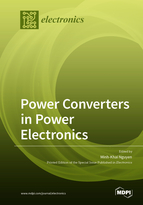Power Converters in Power Electronics
A special issue of Electronics (ISSN 2079-9292). This special issue belongs to the section "Power Electronics".
Deadline for manuscript submissions: closed (31 December 2019) | Viewed by 131952
Special Issue Editor
Interests: power electronics; impedance-source converters; multilevel inverters; PWM strategies; power converters for renewable energy systems and electric vehicles
Special Issues, Collections and Topics in MDPI journals
Special Issue Information
Dear Colleagues,
In recent years, power converters have played an important role in power electronics technology for different applications such as renewable energy system, electric vehicle, pulsed power generation, and biomedical. Power converters in power electronics are becoming essential for generating electrical power energy in various ways. This Special Issue focuses on the development of novel power converter topologies in power electronics.
Topics of interest include but are not limited to the following:
- Z-source converters;
- Multilevel power converter topologies;
- Switched-capacitor-based power converters;
- Power converters for pulsed power generation;
- Power converters in wireless power transfer techniques;
- The reliability of power conversion systems;
- Modulation techniques for advanced power converters.
Technical Program Committee Members:
1. Prof. Xiaoqiang Guo IEEE Senior Member, Department of Electrical Engineering, Yanshan University, Qinhuangdao, 066004, China
Dr. Minh-Khai Nguyen
Guest Editor
Manuscript Submission Information
Manuscripts should be submitted online at www.mdpi.com by registering and logging in to this website. Once you are registered, click here to go to the submission form. Manuscripts can be submitted until the deadline. All submissions that pass pre-check are peer-reviewed. Accepted papers will be published continuously in the journal (as soon as accepted) and will be listed together on the special issue website. Research articles, review articles as well as short communications are invited. For planned papers, a title and short abstract (about 100 words) can be sent to the Editorial Office for announcement on this website.
Submitted manuscripts should not have been published previously, nor be under consideration for publication elsewhere (except conference proceedings papers). All manuscripts are thoroughly refereed through a single-blind peer-review process. A guide for authors and other relevant information for submission of manuscripts is available on the Instructions for Authors page. Electronics is an international peer-reviewed open access semimonthly journal published by MDPI.
Please visit the Instructions for Authors page before submitting a manuscript. The Article Processing Charge (APC) for publication in this open access journal is 2400 CHF (Swiss Francs). Submitted papers should be well formatted and use good English. Authors may use MDPI's English editing service prior to publication or during author revisions.
Keywords
- Multilevel power converters
- Z-source inverters
- Power converter control
- PWM techniques for power converters
- Fault tolerant power converters
- Power converters for pulsed power applications
- Power converters in wireless power transfer techniques






